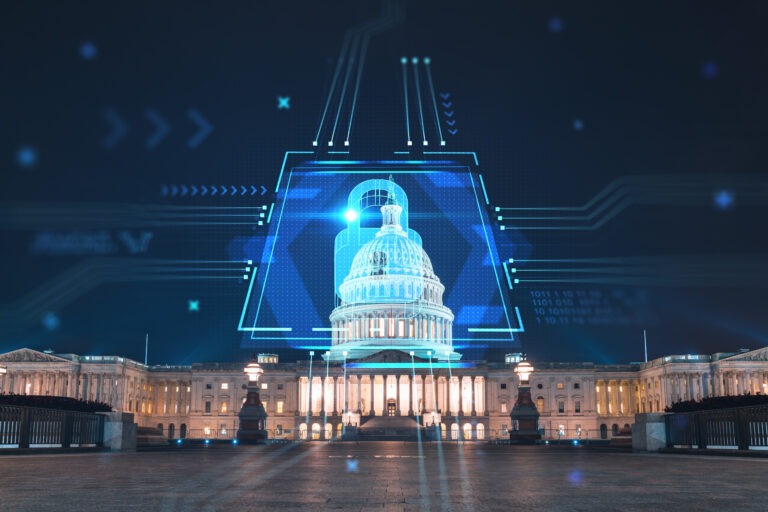

By Sean Paul, SOSi Senior Cybersecurity Engineer
I recently wrote about five key factors the U.S. Government should consider when implementing artificial intelligence into its missions and operations. Further exploring the topic, this article explores how the adoption of AI can significantly enhance three critical mission areas: vulnerability management, threat detection, and threat hunting, with a focus on practical applications within DoD environments.
Revolutionizing Vulnerability Management with AI
Traditional vulnerability management approaches often struggle with prioritization and efficiency. AI offers innovative solutions to these challenges. AI algorithms can analyze vulnerability data to prioritize remediation efforts based on potential impact and ease of remediation, ensuring that critical vulnerabilities are addressed promptly and enhancing overall security posture. For instance, AI can identify which systems require immediate attention by analyzing not only the number of vulnerabilities, but also the complexity of patching and the potential impact on operations.
Additionally, AI can streamline the patching process by identifying patches that address multiple vulnerabilities efficiently, reducing system downtime and resource allocation. This is particularly valuable in complex DoD environments, where managing vulnerabilities across numerous systems and sites can increase risk exposure.
While predictive analytics in vulnerability management is an aspirational goal, it’s important to note the challenges in this area. The unpredictable nature of newly discovered vulnerabilities and the constant evolution of threat tactics make true prediction difficult. However, AI can help identify trends and patterns in vulnerability data, potentially highlighting areas that may require increased attention in the future.
Enhancing Threat Detection Capabilities
As adversaries employ more sophisticated tactics, DoD’s threat detection capabilities must evolve. AI provides powerful tools to combat these challenges, many of which are already integrated into modern Security Information and Event Management (SIEM) solutions.
Machine learning algorithms can analyze vast datasets to identify anomalies and patterns indicative of threats, adapting to evolving threat landscapes and improving detection accuracy over time. ML is particularly valuable in environments like INDOPACOM’s Mission Partner Environment (MPE), where the scale and complexity of operations demand advanced threat detection capabilities.
AI can also establish baselines of normal behavior and identify deviations, making it particularly effective against insider threats and Advanced Persistent Threats (APTs). By integrating and analyzing data from multiple sources, AI provides a comprehensive view of potential threats, improving overall detection accuracy. This is crucial in environments like the Global Cyber Center (GCC) and Regional Cyber Center Europe (RCC-E), where threat detection across diverse networks and systems is a key responsibility.
Transforming Threat Hunting Operations
Proactive threat hunting is crucial for maintaining a strong cybersecurity posture. AI can significantly enhance these efforts, especially in complex environments like those managed by DoD partners. AI can quickly identify patterns and anomalies in network traffic that may indicate malicious activities, isolating suspicious behavior for further investigation. Pattern identification is particularly valuable when managing multiple Elastic Stack instances across hundreds of sites and dozens of countries, as in the INDOPACOM mission.
By correlating alerts from various sources, AI provides a more comprehensive threat picture, enabling security teams to prioritize and respond more effectively. In missions like those carried out by the GCC, where threat hunting across Army networks requires rapid and accurate threat identification, this type of threat picture is essential.
AI can also automate many aspects of threat hunting, from data collection and analysis to suggesting remediation actions, allowing security analysts to focus on strategic tasks, which is crucial in environments where the scale of operations would overwhelm traditional manual approaches.
Implementing AI Responsibly in DoD Environments
As previously explored, while the benefits of AI in cybersecurity are clear, its implementation in DoD environments requires careful consideration. Data governance is crucial, ensuring that role-based access controls are applied at the data level. This means implementing systems and policies for data tagging and access control, ensuring that sensitive information is only accessible to authorized personnel and AI systems.
It’s also important to “ground” AI systems, restricting their access to only the data and systems necessary for their specific functions. This approach helps address concerns about AI’s potential access to sensitive information and builds trust in its use within defense operations.
Measuring Success and ROI
To justify the investment in AI-driven cybersecurity, it’s essential to measure its impact. Key metrics include the reduction in vulnerability exposure time and false positive alerts, improved detection of low-and-slow threats, enhanced efficiency in threat hunting operations, and increased focus on actionable threats. These metrics should be tailored to the specific missions and environments within the DoD, such as the MPE, GCC, and RCC-E.
The Road Ahead
As we face increasingly sophisticated cyber threats, the integration of AI into our cybersecurity operations is not just an upgrade—it’s a necessity. By harnessing AI’s computational power and combining it with the strategic insights of our cybersecurity experts, we can create a more secure and resilient digital infrastructure for our nation’s defense operations.
The future of cybersecurity lies in the confluence between human expertise and AI capabilities. Early adopters of these technologies will gain a significant advantage in the ongoing cyber arms race. As we continue to innovate and adapt, AI will play a crucial role in safeguarding our national security interests in the digital domain.
By embracing AI-driven cybersecurity solutions, the DoD and its partners can stay ahead of adversaries, protect critical assets, and ensure the integrity of our defense systems in an ever-changing threat landscape. With our experience in managing complex environments like the MPE, GCC, and RCC-E, and our ongoing work in AI for intelligence operations, SOSi is uniquely positioned to help the DoD leverage AI for enhanced cybersecurity across its diverse and critical missions.

